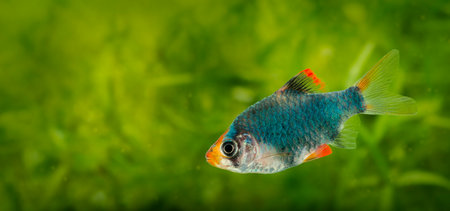1. Introduction to UV Sterilizers
Keeping an aquarium clean and healthy is a top priority for fish keepers. One of the most effective tools for maintaining water quality and preventing diseases is a UV sterilizer. But what exactly is a UV sterilizer, how does it work, and why is it an essential part of an aquarium filtration system? Lets break it down in simple terms.
What Is a UV Sterilizer?
A UV sterilizer is a device that uses ultraviolet (UV) light to kill harmful microorganisms in the water. It helps eliminate bacteria, viruses, parasites, and even algae spores that can cause diseases or cloudy water in aquariums.
How Does a UV Sterilizer Work?
A UV sterilizer consists of a chamber with a specialized UV bulb inside. As water flows through this chamber, it gets exposed to UV-C light, which disrupts the DNA of harmful organisms, rendering them unable to reproduce or survive. This process significantly reduces the risk of disease outbreaks in your tank.
The Role of UV Sterilizers in Aquarium Filtration
UV sterilizers are not a replacement for traditional filtration methods like mechanical, biological, or chemical filtration. Instead, they work alongside these systems to provide extra protection against pathogens. Here’s a breakdown of how they fit into an aquariums overall filtration system:
| Filtration Type | Function |
|---|---|
| Mechanical Filtration | Removes debris like uneaten food and fish waste using filter pads or sponges. |
| Biological Filtration | Uses beneficial bacteria to break down harmful ammonia and nitrites into less toxic nitrates. |
| Chemical Filtration | Removes toxins and impurities using activated carbon or other chemical media. |
| UV Sterilization | Kills harmful bacteria, viruses, parasites, and algae spores to prevent disease spread. |
Why Should You Use a UV Sterilizer?
If you want to maintain crystal-clear water and protect your fish from infections, a UV sterilizer is a valuable addition to your tank setup. It works silently in the background, reducing pathogens without affecting beneficial bacteria living in your biological filter. By integrating a UV sterilizer into your aquarium system, you create a healthier environment for your aquatic pets.
2. Common Aquarium Fish Diseases and Causes
Keeping an aquarium is a rewarding experience, but fish are susceptible to various diseases that can quickly spread if not managed properly. Understanding these common illnesses, their causes, and how they spread is crucial for maintaining a healthy aquatic environment.
Common Aquarium Fish Diseases
Aquarium fish can suffer from a range of diseases, many of which are caused by bacteria, viruses, fungi, or parasites. Below are some of the most common diseases that affect aquarium fish:
| Disease | Cause | Symptoms | How It Spreads |
|---|---|---|---|
| Ich (White Spot Disease) | Parasite (Ichthyophthirius multifiliis) | White spots on body and fins, scratching against objects, rapid gill movement | Spreads through water; introduced by new fish or contaminated equipment |
| Fin Rot | Bacterial infection (Pseudomonas, Aeromonas) | Torn or fraying fins, discoloration, lethargy | Poor water quality, stress, and injuries weaken the immune system |
| Popeye Disease | Bacterial infection or poor water conditions | Bulging eyes, cloudiness in the eye, swelling around the eye socket | Poor water quality and physical injury contribute to infections |
| Dropsy | Bacterial infection affecting internal organs | Bloating, raised scales, lethargy, difficulty swimming | Mainly affects fish with weakened immune systems due to stress or poor conditions |
| Fungal Infections | Saprolegnia, other fungi | Cotton-like growths on skin, fins, or gills; sluggish behavior | Poor water conditions and injuries provide entry points for infection |
| Velvet Disease | Piscinoodinium, a parasitic dinoflagellate | Dusty gold or rust-colored coating on fish’s body, clamped fins, labored breathing | Easily spreads through water and can be introduced by new fish or plants |
| Mouth Fungus (Columnaris) | Bacteria (Flavobacterium columnare) mimicking fungal infections | Cotton-like patches around the mouth, frayed fins, ulcers on the body | Easily spreads in overcrowded tanks with poor filtration and high stress levels |
The Challenges in Preventing Fish Diseases
Aquarium owners face several challenges when it comes to preventing diseases. Many pathogens exist in the tank environment but only become problematic when fish are stressed or their immune systems are weakened. Some key challenges include:
- Poor Water Quality: High ammonia or nitrate levels weaken fish immunity and promote bacterial growth.
- Lack of Quarantine: Introducing new fish without quarantining them first can bring hidden diseases into an established tank.
- Crowded Tanks: Overcrowding increases stress and makes it easier for infections to spread.
- Ineffective Filtration: A weak or dirty filter fails to remove harmful bacteria and organic waste.
- Lack of UV Sterilization: Without UV sterilizers, free-floating bacteria and parasites remain active in the water.
- Poor Nutrition: A diet lacking essential nutrients weakens the immune system and makes fish more vulnerable to disease.
- Chemical Imbalances: Fluctuations in pH levels can cause stress and make fish prone to illness.
The Role of UV Sterilizers in Disease Prevention
A UV sterilizer plays a crucial role in preventing many common fish diseases. It works by exposing harmful microorganisms to ultraviolet light, effectively neutralizing bacteria, viruses, parasites, and algae before they can infect fish. By incorporating a UV sterilizer into your aquarium setup, you significantly reduce the risk of disease outbreaks while maintaining crystal-clear water quality.
![]()
3. How UV Sterilizers Prevent Disease
UV sterilizers play a crucial role in keeping aquarium water clean and free from harmful microorganisms. By exposing water to ultraviolet (UV) light, these devices effectively eliminate bacteria, viruses, and parasites that can cause diseases in fish. This process helps maintain a healthier environment for your aquatic pets.
How UV Sterilization Works
UV sterilizers use a special lamp that emits UV-C light. As water passes through the sterilizer, the UV-C light penetrates the cells of bacteria, viruses, and parasites, disrupting their DNA and preventing them from reproducing. Over time, this significantly reduces the number of harmful pathogens in the aquarium.
Effectiveness of UV Sterilization
The efficiency of a UV sterilizer depends on several factors, such as the strength of the UV light, the exposure time, and the flow rate of water through the unit. When used correctly, UV sterilization can effectively control and reduce disease outbreaks among aquarium fish.
Comparison of Common Aquarium Pathogens and Their Susceptibility to UV Light
| Pathogen Type | Examples | Susceptibility to UV Sterilization |
|---|---|---|
| Bacteria | Aeromonas, Pseudomonas | Highly Effective |
| Viruses | Koi Herpesvirus (KHV) | Moderately Effective |
| Parasites | Ich (Ichthyophthirius multifiliis), Costia | Effective in Free-Swimming Stage |
The Benefits of Using a UV Sterilizer in Your Aquarium
- Disease Prevention: Reduces harmful pathogens in the water before they infect fish.
- Improved Water Clarity: Helps control algae blooms and keeps water crystal clear.
- Lowers Dependency on Medications: Minimizes the need for chemical treatments that may stress fish.
- Aids in Overall Fish Health: Provides a cleaner environment, reducing stress and promoting stronger immune systems.
Limitations of UV Sterilization
While UV sterilizers are highly effective at controlling pathogens, they do have some limitations:
- Ineffective Against Attached Parasites: UV sterilization only works on free-floating organisms; it cannot eliminate parasites already attached to fish.
- No Effect on Toxins or Waste: It does not remove ammonia, nitrites, or other chemical pollutants from the water.
- Lamp Maintenance Required: The UV bulb must be replaced periodically to maintain effectiveness.
A properly maintained UV sterilizer is a valuable tool for any aquarium owner looking to reduce disease risks and improve overall water quality. By integrating it with good filtration and regular tank maintenance, you can create a healthier environment for your fish.
4. Choosing the Right UV Sterilizer for Your Tank
Selecting the right UV sterilizer is essential to ensure it effectively prevents diseases in your aquarium. The size of your tank, water flow rate, and the types of fish you keep all play a role in determining which unit is best for you.
Aquarium Size
The power of a UV sterilizer is measured in watts, and choosing the correct wattage depends on your tanks size. A general guideline is:
| Aquarium Size (Gallons) | Recommended UV Wattage |
|---|---|
| Up to 20 gallons | 5-8W |
| 20-50 gallons | 8-15W |
| 50-100 gallons | 15-25W |
| 100+ gallons | 25W or more |
Water Flow Rate
The effectiveness of a UV sterilizer depends on how long the water is exposed to UV light. If water flows too quickly through the sterilizer, harmful bacteria and parasites may not be properly eliminated. Check the manufacturer’s recommended flow rate for your specific unit:
- Sterilization (killing bacteria & parasites): Requires a slower flow rate.
- Algae control: Can work with a higher flow rate.
- Turbid or cloudy water: May require adjusting flow speed for better results.
Fish Species Considerations
Certain fish species are more sensitive to UV sterilizers than others. For example:
- Sensitive species (e.g., discus, bettas): Choose a lower-wattage unit to prevent excessive exposure.
- Larger community tanks (e.g., cichlids, tetras): A medium-strength sterilizer works well.
- Ponds or large predator tanks: Require high-wattage units for effective disease prevention.
Additional Features to Consider
- Easily replaceable bulbs: UV bulbs need periodic replacement for maximum efficiency.
- Dwell time design: Some models allow for adjustable exposure time.
- Built-in safety features: Look for units with protective housing to prevent leaks or accidental exposure to UV light.
Selecting the right UV sterilizer ensures your aquarium stays healthy and free from harmful pathogens. By considering your tank size, flow rate, and fish species, you can choose a system that fits your needs while keeping your aquatic environment thriving.
5. Best Practices for Maintaining a Healthy Aquarium
Keeping your aquarium clean and free from harmful bacteria is essential for the health of your fish. Proper maintenance, correct usage of a UV sterilizer, and additional preventive measures can go a long way in ensuring a disease-free environment. Here’s what you need to know.
Regular Aquarium Maintenance
Routine maintenance helps prevent the buildup of harmful bacteria and algae. Follow these key steps to maintain a healthy tank:
| Task | Frequency |
|---|---|
| Partial water changes (20-30%) | Weekly |
| Gravel vacuuming | Bi-weekly |
| Filter cleaning (without removing beneficial bacteria) | Monthly |
| Pump and heater inspection | Monthly |
| Aquarium glass cleaning | As needed |
| UV sterilizer bulb check & replacement | Every 6-12 months |
The Proper Use of UV Sterilizers
A UV sterilizer plays a crucial role in reducing harmful pathogens in your tank, but it must be used correctly to be effective.
Selecting the Right UV Sterilizer
- Tank Size: Choose a sterilizer that matches your aquarium’s volume.
- Pump Flow Rate: Ensure the water passes through at the correct speed for optimal sterilization.
- Bulb Wattage: Higher wattage bulbs are more effective in larger tanks.
Tips for Effective Operation
- Run continuously: Keep the UV sterilizer on 24/7 for maximum effectiveness.
- Avoid blocking light: Make sure there are no obstructions inside the chamber.
- Cleansing the quartz sleeve: Clean regularly to remove debris that may reduce efficiency.
- Bulb replacement: Change the UV bulb every 6-12 months, even if it still lights up.
- Adequate flow rate: Adjust flow speed according to manufacturer recommendations for best pathogen removal.
Addition Steps to Prevent Disease in Your Aquarium
Apart from using a UV sterilizer, there are other proactive measures you can take to keep diseases at bay.
Avoid Overcrowding and Overfeeding
- Avoid overcrowding: Too many fish in one tank increases stress and disease risk.
- Maintain proper feeding habits: Feed small amounts that fish can consume within two minutes to prevent food waste buildup.
Add Quarantine Procedures for New Fish or Plants
- Sick fish isolation: If any fish show signs of illness, move them to a quarantine tank immediately.
- Dip new plants in disinfectant solutions: This prevents introducing parasites or bacteria into your main tank.
- Avoid cross-contamination: Use separate nets and tools for different tanks if possible.
Create a Stable Environment for Your Fish
- Keeps water parameters stable: Sudden temperature or pH changes can stress fish, making them more vulnerable to diseases.
- Adequate aeration and filtration: Ensure sufficient oxygen levels and clean water circulation at all times.
- Add beneficial bacteria supplements:
- Select compatible tank mates:
This promotes biological filtration and reduces harmful ammonia buildup.
Avoid aggressive species that could injure or stress other fish.
A combination of regular maintenance, proper use of a UV sterilizer, and careful monitoring of your aquariums conditions will help create a safe and thriving environment for your fish. By following these best practices, you’ll significantly reduce the chances of disease outbreaks and ensure your aquatic pets remain happy and healthy.


